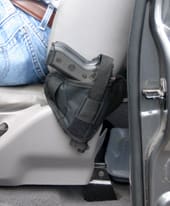 “A Charlotte-Mecklenburg Police Department officer is on paid leave after his 3-year-old stepson found his gun in the back of the family car and shot himself in the thumb in Gastonia,” charlotteobserver.com reports. “The shooting took place around 6:30 p.m. Friday while the car was parked outside an ABC store on Cox Road. Officials said [Winston] Mercedes walked into the store, leaving his wife, stepson and gun in the car. Moments later, the boy found the gun and fired it, striking his thumb. The boy was taken to Carolinas Medical Center and treated for non-life-threatening injuries.” This case raises some interesting question about automotive-related firearms safety . . .
“A Charlotte-Mecklenburg Police Department officer is on paid leave after his 3-year-old stepson found his gun in the back of the family car and shot himself in the thumb in Gastonia,” charlotteobserver.com reports. “The shooting took place around 6:30 p.m. Friday while the car was parked outside an ABC store on Cox Road. Officials said [Winston] Mercedes walked into the store, leaving his wife, stepson and gun in the car. Moments later, the boy found the gun and fired it, striking his thumb. The boy was taken to Carolinas Medical Center and treated for non-life-threatening injuries.” This case raises some interesting question about automotive-related firearms safety . . .
In some states (e.g. Texas), the so-called Castle Doctrine has been extended to a citizen’s automobile. In other words, he or she can defend their car as if it were their home. They can use deadly force to repel carjackers, kidnappers or zombies. That’s provided the gun owner’s life is in danger and they’re actually IN the car.
With a gun. To that end, there are plenty of automobile-compatible gun safes for stashing your gat. Some of them do a pretty good job of offering near-instant access to your firearm. But even the best of the breed are hardly ideal.
Carjackers depend on the element of surprise. A road rager can be at your door within two seconds. A near-instant access safe would have protected Officer Mercedes’s step-son, but it may not have been good enough to protect him in another [let’s admit it less likely] situation.
Alternatively, you could install a bolt-on or strap-on car holster, like the one in the picture above. These automotive accessories put your gun within immediate and instant reach. And when you see those flashing blue lights, you could reach down, grab your weapon and place it in your glove box. You know; so that the officer doesn’t get too jumpy.
Good luck with that. Besides, car holsters violate one of the prime safety rules: a gun should either be on your person or in a locked safe, to prevent de-digitizing (or worse) your children.
Most gun holsters place the weapon at hip level or below. Providing it’s even physically possible, wearing a hip level holster whilst driving is only slightly more comfortable that donning a hair shirt. Listening to the Wiggles. For hours.
By the same token, drawing your weapon from a traditional holster in a driving position is not what I’d call a quick or easy proposition. Or, for that matter, safe. Again, if you’re being carjacked or assaulted when you’re in your car, speed (of draw) is of the essence.
[Note: using a firearm to fend off a carjacker/attacker is, generally speaking, a bad idea. Aiming is problematic. A misplaced shot can be disastrous. The report could cause permanent hearing damage. And there’s no cover. Far better: scram. Always leave enough space between your vehicle and the car in front (a.k.a. “tarmac and tires”) to get the hell out of Dodge.]
A shoulder holster is a reasonable solution to the automotive firearm comfort – access axis, but not many people like shoulder holsters. Especially women, who are most vulnerable to carjacking.
Another potential answer: drive with a much smaller gun (e.g. snub-nosed revolver) in a jacket or pants pocket and store your “normal” carry gun in a portable safe/locked glove box. When you leave the vehicle—even for a minute—switch them ’round.
But what about summer? YOU try putting a .38 in a pair of tight shorts . . .
No one said this was going to be easy. Responsible and effective gun ownership involves compromises. Lots of compromises. There’s only one aspect of ownership you should never compromise: safety. It takes planning and thought and constant vigilance.
At the same time, it’s important to realize that automotive firearms safety—like all firearms safety—is not so much about systems as it is about awareness.
You could, for example, violate the holster/gun safe rule and transport your gun by placing it in a bag made for the purpose. If you NEVER let ANYONE touch that bag or let it out of your sight FOR A SECOND and made sure to holster or lock the gun EVERY TIME you left the car, you’d be good to stow.
In Officer Mercedes case (or lack thereof), he could have had his gun dangling from the rear view mirror and still avoided this near-miss with tragedy. All he had to do was keep an eye on the gun and take it with him or lock it up when he left the car.
Did Mercedes assume his wife would stop his step-son from doing something stupid? Another lapse. The only assumption you can make about kids and guns: they will eventually defeat your security systems. They need to be taught muzzle discipline and trigger control from the git-go.
A responsible gun owner understands that gun safety requires a huge commitment of time, mental energy and, yes, money. But one way or another, you have to pay for safety. Just ask Officer Mercedes.



